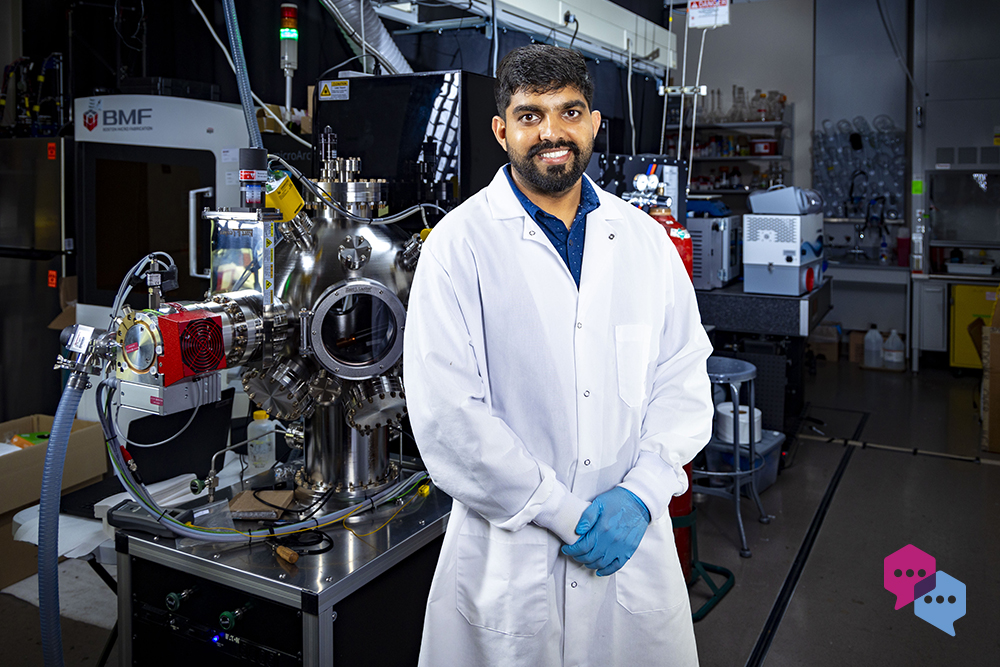Sachin Kadian is a postdoctoral researcher in the Lampe Joint Department of Biomedical Engineering at UNC-Chapel Hill and NC State University. He develops wearable — and painless — microneedle platforms that combine real-time health monitoring with targeted drug delivery.
Q: How did you discover your specific field of study?
A: With a few simple but powerful questions: Why should diagnosis or treatment hurt? We go through blood draws, painful injections, and uncomfortable procedures all the time, but what if there was a better way?
That curiosity led me to think about skincare. Every day, people comfortably use lotions, patches, and serums on their skin. In fact, cosmetic microneedling is already widely used to improve skin health by creating microchannels in the stratum corneum to enhance transdermal delivery of active ingredients and stimulate skin regeneration — all with minimal discomfort and fast recovery. Why can’t we apply the same skin-friendly approach to health care?
By adapting the principles of cosmetic microneedling, my lab and I are developing a small, nearly painless microneedle patch that can easily collect health data from interstitial fluid just beneath the skin and deliver medicine directly to targeted areas. These microneedles bypass the skin’s natural barrier, improving delivery and detection of biomolecules, while also avoiding the pain and inconvenience of traditional methods.
Impact Report
![]()
UNC-Chapel Hill hosts 1,000+ postdoctoral scholars. These positions are crucial for career development between PhD programs and the independent career phase — and are vital to the UNC Research enterprise.
![]()
Five years were added to U.S. life expectancy from 1980 to 2019 because of advancements in medical technology, according to the Advanced Medical Technology Association. Research like Sachin Kadian’s could save lives in North Carolina and beyond.
Q: Academics are problem-solvers. Describe a research challenge you’ve faced and how you overcame it.
A: The skin is a highly protective barrier designed to resist penetration. In the early stages of the project, most of our microneedle prototypes either didn’t function effectively or became clogged quickly, resulting in inconsistent or no fluid collection. At one point, despite having a solid concept, our system was not producing the desired results. So, we took a step back and re-evaluated our approach.
First, we redesigned the needle geometry and integrated a mini reservoir to temporarily store the extracted fluid and channel it toward the sensing electrode. Then, we shifted from hollow to solid microneedles and modified their surface using conductive ink. This innovation allowed the microneedle tip itself to serve as the working electrode, directly accessing interstitial fluid without requiring active extraction.
After multiple design iterations and extensive troubleshooting, we successfully developed a “sensing-on-the-microneedle-tip” platform. This project significantly simplified the system and improved performance. The experience taught me that research challenges aren’t roadblocks — they are opportunities to think creatively, collaborate across disciplines, and explore unconventional solutions.
Q: Describe your research in five words.
A: Microneedle technology revolutionizing health care.
Q: Who or what inspires you? Why?
A: I’m inspired by people who turn challenges into opportunities, especially scientists and engineers who create real-world solutions that truly help others. My family has always been my strongest source of motivation. Their support and values push me to keep going, even when things get tough. I’m also deeply grateful to my mentors who guided me and believed in my ideas before they were fully formed.
Together, they’ve all shaped my purpose to make health care smarter and more accessible for every family, including my own.
Q: If you could pursue any other career, what would it be and why?
A: Science communication or health-focused entrepreneurship. I love breaking down complex ideas and making them understandable and useful for everyone. Whether that’s through writing, speaking, or building innovative products, I’d still want to be solving real-world problems — just in a way that directly connects science with people’s everyday lives. For me, it’s always been about impact, no matter the path.


